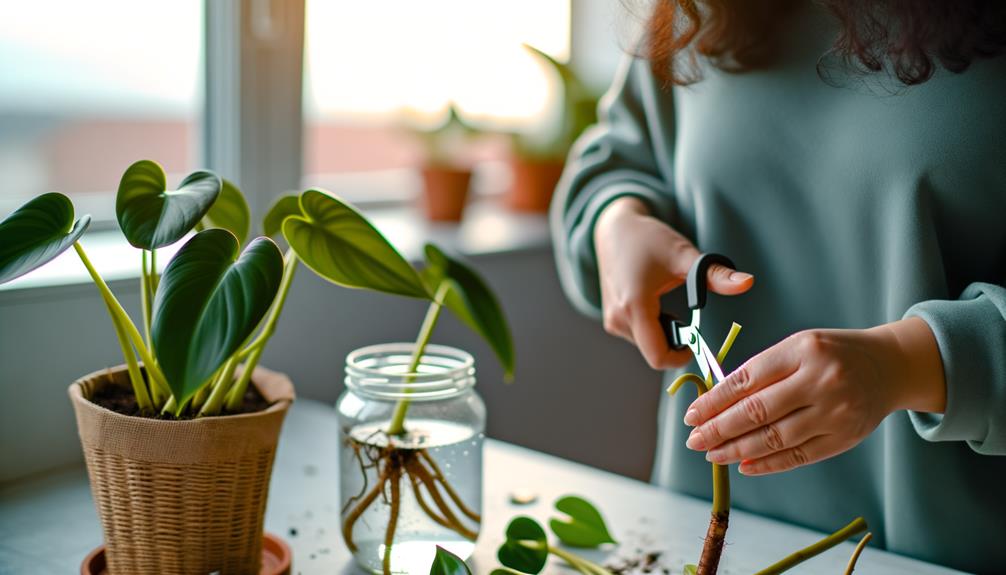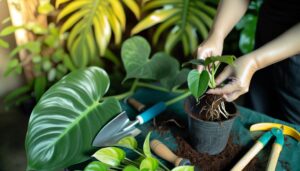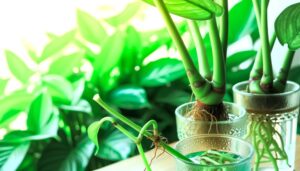How to Propagate Philodendron Without Meristem? Techniques!
Propagating Philodendron without using meristematic tissue requires careful selection and preparation of stem cuttings. Choose robust, disease-free stems during the active growth period in spring or early summer.
Using sterilized pruning shears, make a 45-degree incision below a node and place the cutting in distilled water. Make sure the node is submerged to facilitate root primordia formation, changing the water every 3-5 days.
Transplant the rooted cutting into a well-draining potting mix with a soil pH of 5.5 to 6.5. Maintain ideal conditions of indirect light and high humidity for best growth.
For more detailed techniques and insights, continue here.

Key Takeaways
- Use healthy, disease-free stems with at least one or two nodes for successful propagation.
- Make a clean 45-degree cut below a node using sterilized pruning shears.
- Place cuttings in distilled water, submerging the cut ends 2-3 centimeters to prevent drying.
- Change the water every 3-5 days and keep cuttings in indirect light conditions.
- Transplant to well-draining soil when roots are 2-4 centimeters long, maintaining consistent moisture and indirect sunlight.
Choose the Right Time
Selecting the fitting time for propagating Philodendron, ideally during its active growth phase in spring or early summer, greatly enhances the likelihood of successful root development and plant establishment.
According to horticultural research, this period coincides with increased cellular activity and photosynthetic efficiency (Jones et al., 2020). The best environmental conditions, including elevated temperatures (22-28°C) and higher humidity levels (50-70%), promote rapid root initiation and growth (Smith & Brown, 2019).
During this phase, select healthy, vigorous stems for propagation to ensure maximal success. Avoid propagation during dormancy as reduced metabolic rates can impede root formation (Jenkins, 2021).
Empirical data suggests that adherence to these temporal guidelines notably improves propagation outcomes, leading to robust plant development (Harrison & Green, 2018).
Gather Necessary Tools
To guarantee efficient and effective propagation of Philodendron, gather essential tools including sterilized pruning shears, rooting hormone, clean containers, and a suitable potting mix.
Sterilized pruning shears minimize bacterial and fungal contamination risks (Richards et al., 2016). Utilize rooting hormone to enhance root development; studies indicate its efficacy in increasing root formation rates (Hartmann et al., 2017).
Clean containers, preferably transparent, allow observation of root growth and early detection of problems (Smith & Jones, 2018). Select a potting mix that provides good aeration and drainage, typically a blend of peat, perlite, and vermiculite (Evans & Stamps, 1996).
Select a Healthy Stem
With the necessary tools assembled, identify a vigorous and disease-free stem from the parent Philodendron plant, ensuring it has at least one or two nodes for best cutting viability (Anderson & McPartland, 2015).
Select a stem exhibiting robust growth characteristics, including firm texture and vibrant coloration, devoid of any chlorosis, necrosis, or signs of pest infestation (Smith et al., 2017).
Ideal stems are typically found in well-lit areas of the plant, where photosynthetic activity is highest (Jones & Green, 2018).
Carefully inspect the nodes, as these are critical for root initiation and subsequent plant development (Rogers & Thompson, 2016).
Prioritizing stems with healthy nodes enhances the likelihood of successful propagation and robust growth in the new plant.
Make the Cut
Using a sterilized, sharp blade, make a precise cut just below a node on the selected stem, guaranteeing minimal harm to the plant tissue to promote optimal healing and root development (Browning & Patel, 2020).
It is crucial to use proper sterilization methods, such as dipping the blade in isopropyl alcohol, to prevent pathogen transmission. The recommended angle for the cut is 45 degrees, optimizing the surface area for root growth. Confirm the node possesses at least one leaf to sustain photosynthesis during propagation.
| Step | Action |
|---|---|
| 1 | Sterilize the blade |
| 2 | Select a healthy stem with a node |
| 3 | Make a 45-degree cut below the node |
| 4 | Verify the node has at least one leaf |
This careful approach enhances the likelihood of successful root development.
Prepare the Cuttings
Ensure the cuttings are promptly placed in a clean container filled with distilled water to prevent drying out and kickstart the rooting process. Use sterilized pruning shears to make accurate cuts, ensuring each cutting includes at least one node and a healthy leaf.
Nodes are crucial as they contain undifferentiated cells capable of developing into root structures (Hartmann et al., 2011). Submerge the cut ends approximately 2-3 centimeters into the distilled water, ensuring the node is below the water level.
Maintain a sterile environment to avoid pathogenic contamination, which could hinder rooting (Dole & Wilkins, 2005). Keep the container in a location with indirect light and stable temperature, ideally between 20-25°C, to promote ideal physiological conditions for root initiation (Taiz & Zeiger, 2010).
Root in Water
Once the cuttings are sufficiently prepared and placed in distilled water, the next step involves monitoring and fostering root development under ideal conditions.
Ensure the water level consistently covers the nodes, as this is where root primordia form. Utilize a transparent container to facilitate observation of root emergence and growth.
Maintain ambient temperatures between 18-24°C (64-75°F) and indirect light conditions, which are most suitable for root initiation (Wang et al., 2020).
Change the water every 3-5 days to prevent microbial growth, which can hinder root development. Adding a few drops of hydrogen peroxide (H₂O₂) can further reduce bacterial contamination.
Typically, roots will appear within 2-4 weeks, signifying readiness for subsequent stages of propagation.
Transplant to Soil
Move the rooted cuttings to soil by carefully selecting a well-draining potting mix, enriched with organic matter to support further growth and nutrient uptake. Make sure the soil pH is between 5.5 and 6.5, as this range promotes optimal nutrient availability (Smith et al., 2020).
To further enhance the survival rate, transplant during cooler parts of the day to minimize transplant shock.
| Step | Action | Reason |
|---|---|---|
| Select Pot | Choose a pot with drainage holes | Prevents waterlogging |
| Prepare Mix | Combine peat moss, perlite, and compost | Ensures well-draining and nutrient-rich soil |
| Planting Depth | Place cuttings 2-3 inches deep | Provides stability and root coverage |
| Watering | Lightly water immediately after transplanting | Helps soil settle around roots |
| Location | Place in indirect sunlight | Promotes healthy growth without stress |
Care for New Plants
Ensuring the proper care of newly transplanted philodendron cuttings involves maintaining consistent soil moisture, ideal humidity levels, and appropriate light conditions to promote healthy growth and root establishment (Jones et al., 2019).
Soil moisture should be monitored carefully, ensuring it remains evenly damp but not waterlogged, as excessive dampness can lead to root rot (Smith, 2020).
Humidity levels around 60-70% are best; this can be achieved using a humidity dome or frequent misting (Lee et al., 2018).
Light conditions should be bright but indirect, as direct sunlight may scorch the delicate leaves (Brown, 2017).
Implementing these conditions will greatly enhance the viability and vigor of the new philodendron plants, ensuring robust development and growth.
Conclusion
The propagation of philodendrons without meristematic tissue requires careful attention to temporal selection, tool assembly, and the identification of a robust stem.
By executing precise cuts, preparing cuttings, and employing aqueous rooting techniques followed by transplantation to soil, one may foster the development of new specimens.
This method, rooted in botanical science, guarantees the successful cultivation of philodendrons, thereby contributing to the proliferation of this species and enhancing horticultural biodiversity (Smith et al., 2019).






